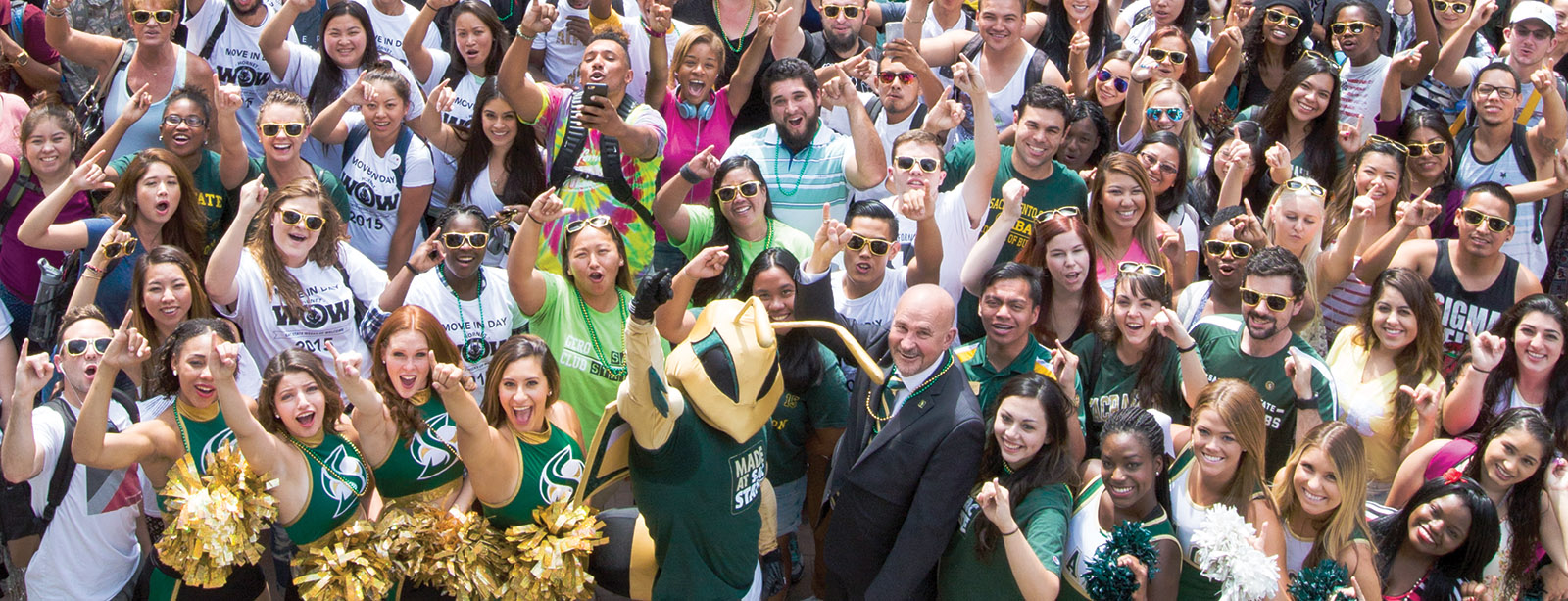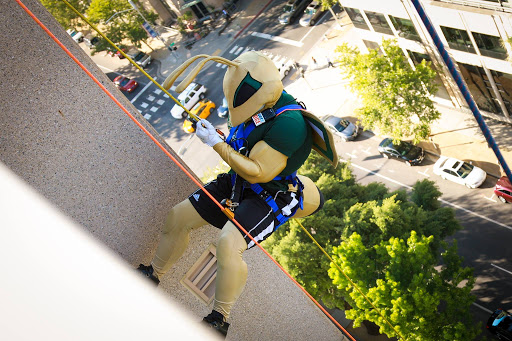

From ‘Bug’ to Big Time, Herky Pulls His Weight
UNTIL NEXT TIME
Ahmed V. Ortiz
"When he’s out there (in the community), he is exemplifying Sacramento State’s excellence." - Professor Tim Howard
Herky explores his feelings in this short video.
A mascot’s place most commonly is on the sidelines. At Sacramento State, where Herky the Hornet reigns, it is anything but.
Across his 70 years, Herky’s role has evolved into one that puts him front and center.
“He’s filling that ambassador role,” says Adam Primas, director of marketing and promotions for Hornet Athletics. Primas is the person who does much of the heavy lifting with all things Herky, from scheduling appearances on and off campus to finding students to fill the suit. In Primas’s 13 years at Sac State, Herky’s profile has evolved radically from when it was common for people to refer to him simply as “the bug.”
And don’t disparage the University’s well-toned totem to the boss.
“Herky is my hero,” says University President Robert S. Nelsen, perhaps his No. 1 fan.
From anonymous to ubiquitous
How Herky got his name is murky, but it’s established that the moniker is a colloquialism for the full name “Hercules” that was bestowed soon after the hornet was selected over the elk as the campus mascot on Dec. 5, 1947. With his now-familiar hulking physique, Herky is well equipped to carry the banner for the University.
“He’s a hallmark to our campus and community,” Marketing Professor Tim Howard says.
For many years, such was not the case.
Upon Primas’s arrival on campus, Herky’s look – it has had more than a couple of less-than-intimidating iterations – “needed updating.” So one of Primas’s first tasks was to call on Alinco Costumes, the nation’s leading mascot outfitter and designer, to bring more heft to Herky in the 21st century.
The happy Hornet became ubiquitous soon after Nelsen arrived in mid-2015. “He always wants Herky with him,” Primas says. “It just took off.”
Howard says the 70-year history creates community capital. Generations of people, from the University’s Golden Grads to Howard’s adolescent children who have grown up going to events with their dad, have an emotional connection to Herky.
“When he’s out there (in the community), he is exemplifying Sacramento State’s excellence,” says Howard, who points to several advantages of having a strong mascot on the front lines of University relations. For one, they don’t get in trouble – or if they do, at least it happens anonymously.
Not to be dismissed is cost. A good-to-great mascot can go a long way toward furthering an organization’s messaging, Howard says, and they are far less expensive than ad campaigns. “If you look at a return on investment, a mascot can be a tremendous complement to your organization’s reputation and brand,” he says.
Herky’s steady presence also eases the pressure of winning and losing. “It gives you that other angle to attract people rather than just what’s happening on the field or on the court,” Primas says. “He’s a draw.”
Great demands, thin resources

HELP HERKY:
Please consider making a contribution
to the Hornet Club/Herky Scholarship
giving.hornetsports.com/pages/sacramento-state-athletics
Or call Adam Primas at 916-278-7551
It can be a weighty responsibility. The appearances at ribbon cuttings and groundbreakings, Homecoming tailgates and donor dining events, to say nothing of sporting events, all happen on the, ahem, Herculean strength of two full-time marketing staffers in Athletics (Primas included), six student employees and two people Primas describes as “casual hires” for game-day duties.
And then there’s the small miracle of finding people to don
the suit.
Many large universities offer mascot scholarships, but Sac State relies on volunteers. Primas has tried advertising the Herky position, but he finds that “uncomfortable.” One year he worked through the cheer team, hoping that outfit’s members could recommend someone who didn’t make the cheerleading cut or knew someone with mascot experience.
How does it work? Primas pauses. “I don’t know,” he says. “We try to get the word out, and we hope somebody responds. I’ve been super lucky.”
Last year, new hope arrived thanks to just such luck. At the end of a five-minute presentation Athletics is granted at freshman orientations, Primas announced he had “one more thing.” A person who had filled the Herky role had graduated. He needed a hero.
A shout came from the back of the room.
A glimpse beneath the antennae
Primas stops an interview: “Let me call him.”
A few seconds pass, a voice on the other end answers, and we’re as close as almost anyone gets to peering under the antennaed headgear, considering that the identities of the humans who bring Herky to life are not made public.
The freshman (now sophomore) who spoke up from the back of the room says that the minimally compensated job of playing Herky – which is shared with one other student – consumes much of his time, but that he loves it. He describes wearing the suit as gaining a super power.
“When I’m in the suit I feel like a Power Ranger,” he says.
Much goes into bringing Herky to life. Requests for his presence often exceed resources. Now that he’s so in demand, finding the time can be tricky. And Herky never works alone. Someone has to serve as a handler to fill tasks such as making sure kids don’t tug his stinger and reading hand signals when Herky needs water.
“It’s difficult to find someone who can understand you when you can’t even talk,” Herky says.
Primas compares Herky’s mental and physical preparation to that of an NFL player. He’s always thinking of things he can do when in persona.
“He’s gonna be one of our best,” Primas says of the current Herky.
Wearing the suit also, of course, requires living a double life of sorts. Inside, you’re a muted superhero, the big man on campus to whom people call out across the Main Quad, and the subject of a thousand selfies.
Outside of it, our Herky is just another student, though he overhears stories of the joy he brings to people in his role. And that’s gratifying enough, he says.
“Herky’s me, and I’m Herky,” he says.
‘All that potential’
Merriam-Webster defines a mascot as “a person, animal, or object used as a symbol to represent a group (such as a sports team) and to bring good luck.”
As the process stands, it takes luck just to find that lucky charm. And although Primas effuses about the long-term prospects for this Herky, who he says would have won out even among dozens of competitors, it would mean so much not to count on luck. He and Howard separately stress what a difference it would make to have a mascot scholarship available.
“You would have 50 people saying ‘I want to be Herky,’ ” Primas says. “But we don’t.”
Howard, who describes himself as a “big-time advocate for the student experience,” says having four or five Herkys would be ideal. Scholarships would allow them to attend mascot camps, which would make an already strong icon that much stronger.
“We have all that potential,” Howard says. “It’s just not been harnessed.”
But there’s still plenty of buzz.
11/12/18